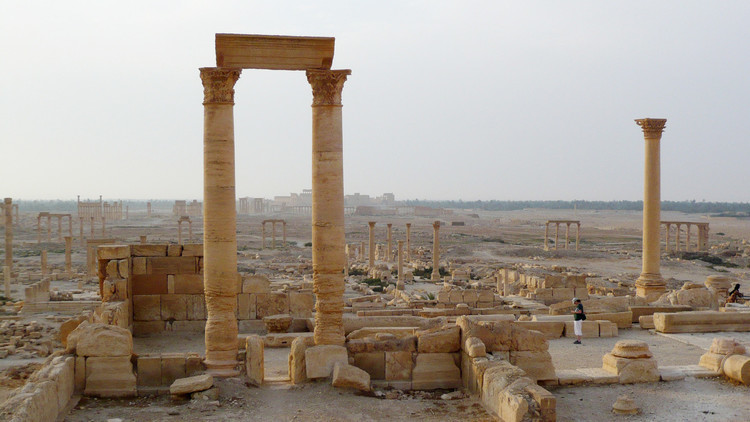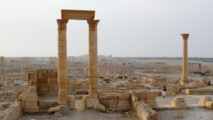It has been just over 10 days since the Syrian regime forces backed by Russian firepower wrested Palmyra from the Islamic State group, which had blown up some of the monuments and staged executions in the Roman amphitheatre.
Now begins the painstaking job of clearing the historic location and neighbouring modern town -- scarred by heavy fighting -- of improvised explosive devices (IEDs) and material left behind.
"Mine-clearance is a tough job wherever you do it and my main concern is that my men stay safe," demining group leader Alexei Makarenko tells AFP, during a highly choreographed visit for journalists organised by the Russian defence ministry.
"But obviously in a place like this you feel an added responsibility."
The recapture of Palmyra and its world famous antiquities has been one of the biggest propaganda coups for Moscow since it launched a bombing campaign to support long-time ally President Bashar al-Assad in September that sparked condemnation in the West.
The demining mission was personally ordered by President Vladimir Putin and the Kremlin is keen for the world to see it as it basks in its latest victory.
In around two days of working among the Roman columns and sand of Palmyra, the Russian team of around 100 sappers and support staff say they have checked around 20 hectares (49 acres) of an area of 234 hectares.
Commander Makarenko says so far at the site they have been finding shells and grenades rather than home-made devices.
He estimates it will take a month to scour the whole area and says that the increasing temperatures of the Syrian desert are already proving tough to deal with.
"We have already had two sappers collapse because of the heat," he says.
- 'Fiery hell' -
In the adjoining modern town -- which once had a population of around 70,000 -- IS fighters appear to have spent more time laying an array of traps for the attacking forces.
One of the main roads through the town is pockmarked with craters where Russian sappers have dug up or exploded bombs hidden under freshly laid strips of tarmac.
Another sapper -- who gives his name only as Major Krivonogov -- shows off some of the devices that the Russians say they found in civilian homes in the city: a bomb that can be triggered by a light switch, a trip wire that sets off a hand grenade.
"These are people with military knowledge who know what they are doing," says Russian military spokesman Igor Konashenkov. "They must have had an IED factory here."
"They wanted to created a fiery hell for the Syrian army when it arrived and that means that there is a lot of work for our guys."
There is also a lot of work ahead to revive the city after the brutal rule of IS and the fierce fighting to reclaim it, in order to allow residents who fled to return.
As local authorities struggle to reestablish basic services, workers in yellow plastic helmets clamber up electricity pylons to try to restore power supplies.
"Palmyra is now totally free of Daesh and now we are in the process of freeing it of mines with the help of our Russian friends," said Talal Al-Barazi, governor of the Homs province, using an Arabic acronym for IS.
"Over the past few days we have started restoring the infrastructure in town such as water supply in order for people to return."
Back among the spectacular antiquities of historic Palmyra, Ahmad Deeb, the director of museum affairs at Syria's culture ministry, is waiting for the Russian demining to finish.
"We have one problem -- we can't reach the burial site because of the high number of mines," he said. "We're waiting to get the go-ahead so that we can assess how much damage there is."
As for the return of tourists to the site -- given the amount of work ahead and the ongoing war in Syria -- Deeb can only dream.
"I wish they would come tomorrow," he said. "But it will take a long time."
----------------------------------------------------------------------------------------------
Now begins the painstaking job of clearing the historic location and neighbouring modern town -- scarred by heavy fighting -- of improvised explosive devices (IEDs) and material left behind.
"Mine-clearance is a tough job wherever you do it and my main concern is that my men stay safe," demining group leader Alexei Makarenko tells AFP, during a highly choreographed visit for journalists organised by the Russian defence ministry.
"But obviously in a place like this you feel an added responsibility."
The recapture of Palmyra and its world famous antiquities has been one of the biggest propaganda coups for Moscow since it launched a bombing campaign to support long-time ally President Bashar al-Assad in September that sparked condemnation in the West.
The demining mission was personally ordered by President Vladimir Putin and the Kremlin is keen for the world to see it as it basks in its latest victory.
In around two days of working among the Roman columns and sand of Palmyra, the Russian team of around 100 sappers and support staff say they have checked around 20 hectares (49 acres) of an area of 234 hectares.
Commander Makarenko says so far at the site they have been finding shells and grenades rather than home-made devices.
He estimates it will take a month to scour the whole area and says that the increasing temperatures of the Syrian desert are already proving tough to deal with.
"We have already had two sappers collapse because of the heat," he says.
- 'Fiery hell' -
In the adjoining modern town -- which once had a population of around 70,000 -- IS fighters appear to have spent more time laying an array of traps for the attacking forces.
One of the main roads through the town is pockmarked with craters where Russian sappers have dug up or exploded bombs hidden under freshly laid strips of tarmac.
Another sapper -- who gives his name only as Major Krivonogov -- shows off some of the devices that the Russians say they found in civilian homes in the city: a bomb that can be triggered by a light switch, a trip wire that sets off a hand grenade.
"These are people with military knowledge who know what they are doing," says Russian military spokesman Igor Konashenkov. "They must have had an IED factory here."
"They wanted to created a fiery hell for the Syrian army when it arrived and that means that there is a lot of work for our guys."
There is also a lot of work ahead to revive the city after the brutal rule of IS and the fierce fighting to reclaim it, in order to allow residents who fled to return.
As local authorities struggle to reestablish basic services, workers in yellow plastic helmets clamber up electricity pylons to try to restore power supplies.
"Palmyra is now totally free of Daesh and now we are in the process of freeing it of mines with the help of our Russian friends," said Talal Al-Barazi, governor of the Homs province, using an Arabic acronym for IS.
"Over the past few days we have started restoring the infrastructure in town such as water supply in order for people to return."
Back among the spectacular antiquities of historic Palmyra, Ahmad Deeb, the director of museum affairs at Syria's culture ministry, is waiting for the Russian demining to finish.
"We have one problem -- we can't reach the burial site because of the high number of mines," he said. "We're waiting to get the go-ahead so that we can assess how much damage there is."
As for the return of tourists to the site -- given the amount of work ahead and the ongoing war in Syria -- Deeb can only dream.
"I wish they would come tomorrow," he said. "But it will take a long time."
----------------------------------------------------------------------------------------------









 Home
Home Politics
Politics











